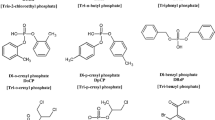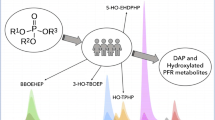Abstract
Organophosphate triesters tris(1,3-dichloro-2-propyl) phosphate (TDCPP) and triphenyl phosphate are widely used flame retardants (FRs) present in many products common to human environments, yet understanding of human exposure and health effects of these compounds is limited. Monitoring urinary metabolites as biomarkers of exposure can be a valuable aid for improving this understanding; however, no previously published method exists for the analysis of the primary TDCPP metabolite, bis(1,3-dichloro-2-propyl) phosphate (BDCPP), in human urine. Here, we present a method to extract the metabolites BDCPP and diphenyl phosphate (DPP) in human urine using mixed-mode anion exchange solid phase extraction and mass-labeled internal standards with analysis by atmospheric pressure chemical ionization liquid chromatography tandem mass spectrometry. The method detection limit was 8 pg mL−1 urine for BDCPP and 204 pg mL−1 for DPP. Recoveries of analytes spiked into urine ranged from 82 ± 10% to 91 ± 4% for BDCPP and from 72 ± 12% to 76 ± 8% for DPP. Analysis of a small number of urine samples (n = 9) randomly collected from non-occupationally exposed adults revealed the presence of both BDCPP and DPP in all samples. Non-normalized urinary concentrations ranged from 46–1,662 pg BDCPP mL−1 to 287–7,443 pg DPP mL−1, with geometric means of 147 pg BDCPP mL−1 and 1,074 pg DPP mL−1. Levels of DPP were higher than those of BDCPP in 89% of samples. The presented method is simple and sufficiently sensitive to detect these FR metabolites in humans and may be applied to future studies to increase our understanding of exposure to and potential health effects from FRs.

The flame retardant TDCPP is metabolized to BDCPP and detected in human urine.




Similar content being viewed by others
References
Marklund A, Andersson B, Haglund P (2003) Screening of organophosphorus compounds and their distribution in various indoor environments. Chemosphere 53(9):1137–1146
Reemtsma T, Quintana JB, Rodil R, García-López M, Rodríguez I (2008) Organophosphorus flame retardants and plasticizers in water and air I. Occurrence and fate. Trends Anal Chem 27(9):727–737
Stapleton HM, Klosterhaus S, Eagle S, Fuh J, Meeker JD, Blum A, Webster TF (2009) Detection of organophosphate flame retardants in furniture foam and U.S. house dust. Environ Sci Technol 43(19):7490–7495
Van den Eede N, Dirtu AC, Neels H, Covaci A (2011) Analytical developments and preliminary assessment of human exposure to organophosphate flame retardants from indoor dust. Environ Int 37(2):454–461
Kanerva L, Jolanki R, Estlander T (1997) Allergic and irritant patch test reactions to plastic and glue allergens. Contact Derm 37(6):301–302
O’Driscoll JB, Marcus R, Beck MH (1989) Occupational allergic contact dermatitis from triphenyl phosphite. Contact Derm 20(5):392–393
Honkakoski P, Palvimo JJ, Penttilä L, Vepsäläinen J, Auriola S (2004) Effects of triaryl phosphates on mouse and human nuclear receptors. Biochem Pharm 67(1):97–106
Sato T, Watanabe K, Nagase H, Kito H, Niikawa M, Yoshioka Y (1997) Investigation of the hemolytic effects of various organophosphoric acid triesters (OPEs) and their structure–activity relationship. Toxicol Environ Chem 59:305–313
WHO (1991) Environmental Health Criteria 111: triphenyl phosphate. World Health Organization, Geneva
Gold MD, Blum A, Ames BN (1978) Another flame-retardant, tris-(1,3-dichloro-2-propyl)-phosphate, and its expected metabolites are mutagens. Science 1978(4343):785–787
Soederlund EJ, Dybing E, Holme JA, Hongslo JK, Rivedal E, Sanner T, Nelson SD (1985) Comparative genotoxicity and nephrotoxicity studies of the two halogenated flame retardants tris(1,3-dichloro-2-propyl) phosphate and tris(2,3-dibromopropyl) phosphate. Acta Pharmacol Toxicol 56:20–29
Dishaw LV, Powers CM, Ryde IT, Roberts SC, Seidler FJ, Slotkin TA, Stapleton HM (2011) Is the PentaBDE replacement, tris(1,3-dichloro-2-propyl) phosphate (TDCPP), a developmental neurotoxicant? Studies in PC12 cells. Toxicol Appl Pharm, doi:10.1016/j.taap.2011.01.005
Meeker JD, Stapleton HM (2010) House dust concentrations of organophosphate flame retardants in relation to hormone levels and semen quality parameters. Environ Health Perspect 118(3):318–323
Nomeir AA, Kato S, Matthews HB (1981) The metabolism and disposition of tris(1,3-dichloro-2-propyl) phosphate (fyrol fr-2) in the rat. Toxicol Appl Pharm 57(3):401–413
Lynn RK, Wong K, Garviegould C, Kennish JM (1981) Disposition of the flame-retardant, tris(1,3-dichloro-2-propyl) phosphate, in the rat. Drug Metab Disposition 9(5):434–441
Sasaki K, Suzuki T, Takeda M, Uchiyama M (1984) Metabolism of phosphoric-acid triesters by rat-liver homogenate. B Environ Contam Tox 33(3):281–288
Reemtsma T, Lingott J, Roegler S (2011) Determination of 14 monoalkyl phosphates, dialkyl phosphates and dialkyl thiophosphates by LC-MS/MS in human urinary samples. Sci Tot Environ 409(10):1990–1993
Schindler BK, Forster K, Angerer J (2009) Determination of human urinary organophosphate flame retardant metabolites by solid-phase extraction and gas chromatography-tandem mass spectrometry. J Chromatogr B 877(4):375–381
Moller K, Crescenzi C, Nilsson U (2004) Determination of a flame retardant hydrolysis product in human urine by SPE and LC-MS. Comparison of molecularly imprinted solid-phase extraction with a mixed-mode anion exchanger. Anal Bioanal Chem 378(1):197–204
Chemical Abstracts Service: Columbus, OH, 2011; RN 115-86-6 (diphenyl phosphate) and RN 13674-87-8 (tris(1,3-dichloro-2-propyl) phosphate; pK a values, calculated using Advanced Chemistry Development (ACD/Labs) Software V11.02. (2011)
Matuszewski BK, Constanzer ML, Chavez-Eng CM (2003) Strategies for the assessment of matrix effect in quantitative bioanalytical methods based on HPLC–MS/MS. Anal Chem 75(13):3019–3030
Haynes WM (2011) (ed) CRC handbook of chemistry and physics, 91st edn (Internet Version 2011). CRC Press, Boca Raton
Simerville JA, Maxted WC, Pahira JJ (2005) Urinalysis: a comprehensive review. Am Fam Physician 71(6):1153–1162
Encyclopedia ADAMME (2009) Atlanta (GA): A.D.A.M., Inc.; ©2005. Creatinine-urine (updated 2009 Aug 7). Available from: http://www.nlm.nih.gov/medlineplus/ency/article/003610.htm. Accessed 2 Apr 2011
Encyclopedia ADAMME Atlanta (GA): A.D.A.M., Inc.; ©2005. Protein-urine (updated 2009 Aug 7). Available from: http://www.nlm.nih.gov/medlineplus/ency/article/003580.htm. Accessed 2 Apr 2011
Markley TA, Forsyth M, Hughes AE (2007) Corrosion protection of AA2024-T3 using rare earth diphenyl phosphates. Electrochim Acta 52:4024–4031
Yu T, Lin C-T (1997) Performance of in-situ phosphatizing reagents in solvent-borne paints. Ind Eng Chem Res 36:368–374
Camacho W, Karlsson S (2000) Quality-determination of recycled plastic packaging waste by identification of contaminants by GC-MS after microwave assisted extraction (MAE). Polym Degrad Stab 71:123–134
Shinagawa Y, Murayama M, Sakaino Y (1992) Investigation of the archival stability of cellulose triacetate film: the effect of additives to CTA support. Spec Publ - R Soc Chem 105:138–150
Meeker JD, Yang T, Ye X, Calafat AM, Hauser R (2010) Urinary concentrations of parabens and serum hormone levels, semen quality parameters, and sperm DNA damage. Environ Health Perspect 119(2):252–257. doi:10.1289/ehp.1002238
Acknowledgments
The authors thank Alex Konstantinov and Wellington Labs, Inc. for synthesis and donation of BDCPP, and Dr. Vladimir N. Belov at Max Planck Institute for Biophysical Chemistry, Göttingen, Germany, for synthesis of d10-BDCPP and d10-DPP. The authors also acknowledge funding support from NIEHS (grants RO1ES016099 and RO1ES015829). Alexander van Nuijs and Adrian Covaci are financially supported by Ph.D. and postdoctoral fellowships, respectively, from the Research Scientific Foundation-Flanders (FWO).
Author information
Authors and Affiliations
Corresponding author
Rights and permissions
About this article
Cite this article
Cooper, E.M., Covaci, A., van Nuijs, A.L.N. et al. Analysis of the flame retardant metabolites bis(1,3-dichloro-2-propyl) phosphate (BDCPP) and diphenyl phosphate (DPP) in urine using liquid chromatography–tandem mass spectrometry. Anal Bioanal Chem 401, 2123–2132 (2011). https://doi.org/10.1007/s00216-011-5294-7
Received:
Revised:
Accepted:
Published:
Issue Date:
DOI: https://doi.org/10.1007/s00216-011-5294-7




